Nummulite
This article includes a list of general references, but it lacks sufficient corresponding inline citations. (November 2015) |
| Nummulites Temporal range: Tertiary
| |
|---|---|
| Scientific classification | |
| Domain: | |
| Kingdom: | |
| Superphylum: | |
| Phylum: | |
| Order: | |
| Superfamily: | |
| Family: | |
| Genus: | Nummulites Lamarck, 1801
|
| Species | |
|
Numerous | |


A nummulite is a large lenticular fossil, characterized by its numerous coils, subdivided by septa into chambers. They are the shells of the fossil and present-day marine protozoan Nummulites, a type of foraminiferan. Nummulites commonly vary in diameter from 1.3 cm (0.5 inches) to 5 cm (2 inches)[1] and are common in Eocene to Miocene marine rocks, particularly around southwest Asia and the Mediterranean (e.g. Eocene limestones from Egypt). Fossils up to 6 inches wide are found in the Middle Eocene rocks of Turkey.2 They are valuable as index fossils.

The ancient Egyptians used nummulite shells as coins and the pyramids were constructed using limestone that contained nummulites.[2] It is not surprising then that the name "Nummulites" is a diminutive form of the Latin nummulus meaning "little coin", a reference to their shape.
In 1913, naturalist Randolph Kirkpatrick published a book, The Nummulosphere: an account of the Organic Origin of so-called Igneous Rocks and Abyssal Red Clays, proposing the unconventional theory that all rocks had been produced through the accumulation of forams such as Nummulites.
References
- 'Nummulite', Tiscali Dictionary of Animals [1], retrieved 17 August 2004
- 2. 'Biggest Microbes', Guinness World Records 2001, p. 153.
- http://paleopolis.rediris.es/cg/CG2006_M02/index.html
Further Reading
Aigner, Thomas (January 1985). "Biofabrics as Dynamic Indicators in Nummulite Accumulations". Journal of Sedimentary Research. 55 (1): 131–134. doi:10.1306/212F8634-2B24-11D7-8648000102C1865D. {{cite journal}}: |access-date= requires |url= (help)
Kopaevich, L.F.; Lygina, E.A.; Nikishin, A.M.; Yakovishina, E.V. (2008). "The Crimean Eocene Nummulite Bank". Moscow University Geology Bulletin. 63 (3): 195-8. doi:10.3103/S0145875208030083. {{cite journal}}: |access-date= requires |url= (help)
Racey, Andrew (2001). "A Review of Eocene Nummulite Accumulations: Structure, Formation and Reservoir Potential". Journal of Petroleum Geology. 24 (1): 79–100. doi:10.1111/j.1747-5457.2001.tb00662.x. {{cite journal}}: |access-date= requires |url= (help)
Papazzoni, Cesare Andrea (1995). "Nummulite biostratigraphy at the Middle/Upper Eocene boundary in the northern Mediterranean area". Rivista italiana di paleontologia e stratigrafia. 101 (1): 63–80. {{cite journal}}: |access-date= requires |url= (help)
Guido, Adriano; Papazzoni, Cesare; Mastandrea, Adelaide; Morsilli, Michele; La Russa, Mauro F.; Tosti, Fabio; Russo, Franco (June 2011). "Automicrite in a 'nummulite bank' from the Monte Saraceno (Southern Italy): evidence for synsedimentary cementation". Sedimentology. 58 (4): 878–889. doi:10.1111/j.1365-3091.2010.01187.x. {{cite journal}}: |access-date= requires |url= (help)
